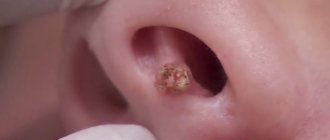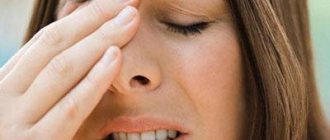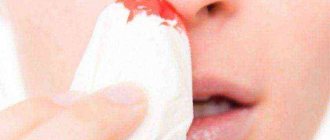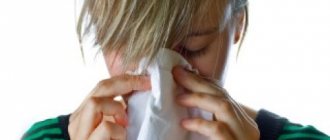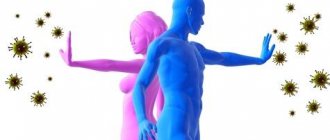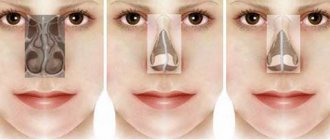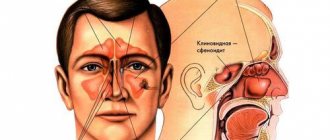General information
Nasal polyps (syn. polypous rhinosinusitis) are benign limited growths of hypertrophied/inflamed mucous membrane of the paranasal sinuses/nasal cavity, characterized by recurrent growth.
Polyps can be either single or multiple. The term “polyposis” is usually used when there are more than 10-20 polyps. Polypous rhinosinusitis (PRS) is a fairly common occurrence at any age, especially in individuals with chronic runny nose , chronic sinusitis , bronchial asthma , hay fever and intolerance to NSAIDs. The prevalence of PRS in the Russian Federation varies from 1 to 5%.
It was noted that the disease is more common in men than in women (2.2:1), mainly in patients over 30 years of age with a pronounced predominance in people in the age group of 50-60 years (average age 42 years). Nasal polyps in children and adolescents (under 20 years of age) are relatively rare. This disease is characterized by a severe course and a high relapse rate.
Histologically, the nasal polyp consists of damaged, often metaplastic epithelium located on a thickened basal membrane/edematous stroma, which contains a small number of glands and vessels, and there are practically no nerve endings. The stroma of the polyp contains fibroblasts, which form its supporting frame, as well as pseudocysts and cellular elements, among which eosinophils predominate, located directly under the surface epithelium and around the glands/vessels.
The formation of nasal polyps is caused by hypertrophy (excessive growth) of the nasal mucosa, which most often occurs as a result of a long-term inflammatory process. Hypertrophy of the nasal mucosa is considered as a compensatory mechanism for the inflammatory process in the nasal mucosa/sinuses, leading to an increase in the area of the mucosa, which leads to the formation of polyps. Most often, polyps develop from the maxillary/sphenoid sinuses, cells of the ethmoidal labyrinth, in the middle meatus/superior and middle turbinates; on the lateral wall of the nose. There are both solitary polyps, when one sinus is affected, and diffuse bilateral PRS, which is characterized by progressive damage to all SNPs/nasal cavity.
A separate nosological form is the choanal polyp (fibroma of the nasopharyngeal tract), which, despite certain similarities with the clinical picture of polypous rhinosinusitis/morphological structure of the formation, has different etio/pathogenetic mechanisms of development. The appearance of this type of polyp in the nasal sinuses is facilitated by various variants of abnormal development of the medial wall of the maxillary sinus. Developmental processes in the posterior nasal cavity also play a role, contributing to changes in the aerodynamics of the nasal cavity and the formation of single/multiple additional anastomosis in the posterior fontanella (photo on the right).
Choanal polyp is a rare pathology, the proportion of which does not exceed 4-6% of the number of various polypous rhinosinusitis and is more common in children. Based on the formation of the stalk of polyps in various anatomical structures, two types of choanal polyps can be distinguished: antrochoanal (polyp of the maxillary sinus) and sphenochoanal (growing from the sphenoid sinus).
What are the causes and what do nasal polyps look like?
Polyps are neoplasms that form on the nasal mucosa. This pathology occurs in children at different ages.
Polyps are a polyetiological disease that occurs due to various reasons. Among the main ones it is worth highlighting:
- Abnormal structure of the nasal cavity. In this case we are talking about narrow passages and curvature of the septum.
- Pathologies of the nasal cavity and sinuses.
- Allergy. This could be bronchial asthma, hay fever and more.
- Cystic fibrosis. This is a genetic disease that is inherited. It is characterized by disruption of the exocrine glands and other body systems.
- Churg-Strauss syndrome. The disease is quite rare and is characterized by damage to small vessels that are responsible for tissue circulation.
- Predisposition to pathology.
There are also other reasons that can lead to the formation of nasal polyps in a child. Such neoplasms have a teardrop-shaped and round shape.
Pathogenesis
The pathogenetic mechanisms of the formation and development of nasal polyps are widely discussed and not fully understood. According to many authors, the pathogenesis is based on the chronic inflammatory process (eosinophilic inflammation), which contributes to a qualitative change in the glycoproteins of the basement membrane, as well as vasodilation, exudation, deposits and fibrin organization.
An important role in the pathogenesis of the disease is assigned to the allergic component, that is, PRS is considered an infectious-allergic disease. Analysis of the literature data allows us to conclude that at least three types of allergic reactions are involved (I – reagin; III – immunocomplex; IV – delayed-type hypersensitivity).
Proponents of the autoimmune concept believe that the leading trigger for the autoallergic process is the direct effect on the mucous membrane of an infectious agent, which contributes to the development of chronic inflammation, as a result of which the nasal mucosa acquires the specific properties of the antigen. Accordingly, in response to the influence of complex antigens, which contain association products of microbial and tissue components, autoantibodies are synthesized in the body. The formation of immune complexes, in turn, leads to a cytotoxic effect on the mucous membrane of the paranasal sinuses/nasal cavity, causing its further changes. Thus, a cyclical process is formed, which becomes sluggish and long-term in nature with a high tendency to relapse.
There are other theories of the pathogenesis of the disease that suggest the participation of mechanical, constitutional and genetic factors in the etiopathogenesis of nasal polyposis. Thus, it is assumed that the development of nasal polyps is based on a local insufficiency of the mechanisms responsible for cleansing the nasal mucosa from inflammatory alteration products.
The gradual accumulation of such products contributes to long-term persistence of inflammation and increased local inflammatory edema with the development of a proliferative process and subsequent sclerosis of stromal elements. Such morphological changes in polyps lead to the development of lymphostasis, caused by dynamic insufficiency of the lymphatic bed; in an upright position, it helps to strengthen the “noose” mechanism in the anastomosis area. Also, according to a number of authors, the development of a local polypous process may be due to a violation of the aerodynamics of the nasal cavity due to anomalies/disturbances in the structure of the intranasal structures.
According to the theory of multifactoriality, various congenital/acquired biological defects can potentially exist in the human body at various levels (organ, cellular/subcellular), in particular, in the form of a pronounced imbalance of the autonomic nervous system, including hyperreactivity of the parasympathetic department. These defects can manifest clinically if there are provoking environmental factors (mechanical/physical/chemical influences, infectious agents or allergens) that act as a trigger. The severity of the reaction is determined by a number of factors: the virulence of the pathogen, local/general nonspecific and specific reactivity, the response of the autonomic nervous system, the nature of the dysfunction of the mucous membrane caused by obstacles (local malformations) in the path of mucociliary transport and elements of the mucous membrane (cilia immobility syndrome, etc. .), performing mucociliary transport.
Why do polyps occur?
Typically, this problem affects children under 10 years of age. Unfortunately, modern medicine has not yet come to a consensus regarding the background against which polyps develop. But, nevertheless, there are a number of prerequisites that can affect the occurrence of the disease:
- anatomical predisposition - a deviated nasal septum or the airways are too narrow;
- if the baby constantly deals with inflammatory diseases of the nose or paranasal sinuses - frontal sinusitis, sinusitis or rhinitis;
- allergic reactions such as hay fever, allergic asthma and dermatitis can also become triggers for the development of polyps;
- if a child has inherited cystic fibrosis, there are disturbances in the functioning of the exocrine glands, and dysfunction of the respiratory, musculoskeletal and digestive systems is noted;
- with Churg-Strauss syndrome - damage to capillaries in the body, including the nose;
- genetic predisposition.
All these points can affect the development of nasal polyps in a child. Therefore, if parents know that their baby is often sick, then they should pay double attention to the health of their child. After all, it’s better to be safe than sorry about something later.
Classification
There is no generally accepted classification of PRS. In routine clinical practice, it is customary to divide PRS based on possible etiological factors, features of the clinical course and the histological structure of the polyps.
According to the etio-pathogenetic principle, the following are distinguished:
- Polyposis caused by aerodynamic disturbances in the SNA/nasal cavity.
- Polyposis caused by chronic sluggish purulent inflammation of the mucous membrane of the SNP/nasal cavity.
- Polyposis caused by fungal infection of the mucous membrane of the SNP.
- Polyposis is based on disturbances in the metabolism of arachidonic acid .
- Polyposis in Kartagener syndrome/cystic fibrosis .
Based on the histological structure, they are distinguished:
- Fibroinflammatory polyps (neutrophilic).
- Edema, eosinophilic polyps.
- Glandular polyps.
- Polyps with atypical stroma.
According to endoscopic studies, several stages are distinguished that characterize the prevalence of the polyposis process:
- Stage 1 – it is characterized by persistent diffuse swelling of the mucous membrane localized in the middle nasal meatus.
- Stage 2 – polyps that are located in the middle nasal meatus and do not extend beyond its boundaries.
- Stage 2 - polyps already extend directly beyond the boundaries of the middle nasal meatus/localization of polypous changes in the mucous membrane on the medial surface of the nasal concha.
- Stage 4 – the presence of polyps in the common nasal passage.
According to the morphological classification, nasal polyps go through two stages of development: the stage of glandular-cystic (edematous) polyp and the stage of fibrous polyp.
Why are nasal polyps dangerous?
Formations in the nasal passages create conditions for the following phenomena:
- Difficulties in the release of contents from the sinuses initiates inflammation of the mucous membrane, which, in turn, again reinforces the process of creating new polyps.
- Overgrown polypous formations can completely block the respiratory passages. In this case, breathing through the nose becomes impossible. The person experiences severe discomfort and breathes through the mouth. Such a case requires urgent surgical intervention.
- Polyps are benign formations. The biggest danger lies in the fact that they can degenerate into cancerous tumors.
Causes
The causes of nasal polyps are not fully understood today. The main reasons include:
- Long-term, sluggish inflammation of the nasal cavity/sinuses ( sinusitis , chronic rhinitis , ethmoiditis ).
- Allergic diseases ( allergic rhinitis , bronchial asthma ), contributing to damage to the mucous membrane and its polypous degeneration.
- Hereditary factors ( cystic fibrosis , which is characterized by the accumulation of viscous secretions that cause inflammation in the sinuses and Kartagener syndrome with an autosomal recessive type of inheritance, in which the formation of polyps is caused by dysfunction of the motor cilia of the ciliated epithelium).
- Anatomical features/anomalies of the structure of the nose (deviated septum, narrowness of the nasal passages, anomalies of the middle turbinate, fissure in the nose) causing disturbances in the aerodynamics of the nasal cavity and contributing to the development of a local polypous process.
Complications
The main danger of the pathology lies in provoking the development of bronchial asthma. In addition, polyps lead to dysfunction of the respiratory system or malocclusion. This means that the formation of nasal polyps in children is a common phenomenon that is difficult to detect in the early stages. To diagnose the pathology in a timely manner, bring your child for examination to a doctor at the first signs of nasal congestion. Remember that only a doctor can provide the right treatment for your baby, so don’t be afraid to visit the hospital. Remember that the sooner you begin to eliminate the pathology, the lower the risk of irreversible phenomena.
Where to go? ENT clinics in Moscow:
Our Time Moscow, Leninsky Proezd, 103 SM-Clinic in Staropetrovsky Proezd (formerly Cosmonaut Volkov) Moscow, Staropetrovsky Proezd, 7A, p. 22 Policlinika.ru Red Gate Moscow, st. Novaya Basmannaya, 10, building 1 Children's department on Volgogradsky Prospekt (metro Tekstilshchiki) Moscow, Volgogradsky Prospekt, 42, building 12 Medical center Tsentraviamed on Sakharova Moscow, Ulansky per., 22, building 1 Koshelev Alexey Vladimirovich Moscow, Zemlyanoy Val, 64, building 2 All ENT clinics in Moscow on the map
Symptoms of nasal polyps
Nasal polyps in adults manifest with patient complaints of persistent nasal congestion and varying degrees of difficulty in nasal breathing and snoring. Moreover, as the polyps grow, partial nasal congestion often turns into a complete blockage, which forces the patient to breathe through the mouth. The use of vasoconstrictor drops, as a rule, does not eliminate nasal congestion.
Long-term disruption of nasal breathing caused by nasal polyps leads to disorders of lymph/blood circulation in the brain area, which is manifested by increased fatigue, the appearance of headaches without a specific localization, decreased mental performance and sleep disturbances in patients. Most people with nasal polyps experience frequent sneezing/ running nose . Patients often complain of a deterioration in their sense of smell, including a complete inability to perceive smells ( anosmia ).
Some patients experience constant discomfort in the nose or a sensation of a foreign body. There may be pain in the various paranasal sinuses and thick nasal discharge (clumps of mucus). When polyps are localized in the posterior parts of the nasal cavity, a characteristic symptom is the appearance of nasal sounds (rhinolalia). What nasal polyps look like is shown below (photo of nasal polyps).
In general, the symptoms of nasal polyposis in adults and their severity are determined directly by the extent of the pathological process.
Symptoms and treatment of nasal polyps in a child + video
Not only adults, but also children can face such a problem as nasal polyps. Knowledge about polyposis helps parents consult a doctor in time to diagnose the disease and find the correct treatment regimen.
How and why polyps occur
Nasal polyps are not painful, non-tender, round or teardrop-shaped formations caused by the growth of the nasal mucosa. They can be solid or gelatinous. The size of the polyp can vary from a few millimeters to 3-4 centimeters in diameter.
You might be interested in: Squamous cell papilloma: skin, larynx, esophagus and stomach, what is this disease and how to treat it?
The size of the polyp can reach several centimeters
Children are more likely to develop formations that grow from the mucous membranes of the maxillary sinuses and are located on one side - the so-called anthropoanalytic polyps.
Stages of the disease
Depending on the size of the formations, three stages of polypoposis are distinguished:
- first - polyps cover a small, often nasal passage;
- second, expanding connective tissue covers most of the airways;
- third - the formations completely cover the nasal breathing.
At-risk groups
The causes of polyps are not reliably known. Children with such characteristics and diseases are most predisposed to their occurrence:
- anatomically narrow nasal passages, deviated septum;
- allergies;
- chronic diseases of the nasopharynx, such as tonsillitis, rhinitis, sinusitis and others;
- fibrocystic degeneration is a rare hereditary disease;
- Strauss syndrome of the cervix is a rare disorder of small blood vessels;
- hereditary predisposition;
- weakened immunity.
Polyps are more common in children under 3-10 years of age .
Why is polyposis dangerous?
They often cause angina, tonsillitis, and enlarged polyps. Their negative impact on hearing is due to the fact that polyps block the auditory canals as they grow. Enlarged polyps lead to disruption of the formation of the skull and teeth. The bite becomes uneven and cosmetic defects may occur.
Polyps in children in the first year of life are especially dangerous because babies cannot yet breathe through their mouths. Breathing disorders cause sleep and eating disorders. They can lead to malnutrition, weight loss and bronchial pathology. And hearing loss negatively affects speech development and leads to underdevelopment of the child.
Symptoms
The initial stage of polyp formation is often asymptomatic. When they increase, the first signs resembling a cold appear:
- foamy nasal discharge;
- sneezing;
- clogged nose;
- labored breathing.
Nasal polyps cause foamy discharge
As polyps grow, they begin to put pressure on the blood vessels in the nose, causing poor blood flow and making it easier for viruses to enter . The child begins to complain of headaches. Parents may also notice sleep disturbances and decreased brain activity.
When polyps reach large sizes, symptoms become more pronounced:
- increased headache;
- snoring during sleep;
- pain in the sinuses;
- sensation of a foreign body in the nose;
- damage to the sense of smell, sometimes its complete loss;
- change in taste.
In addition to the above, external signs appear:
- Breathing is mainly through the mouth;
- Smoothing the nasolabial fold;
- Sluggishness of the jaw.
For young children the situation is more complicated because they cannot tell us what is bothering them. Early detection of nasal polyps depends entirely on the attention of parents.
Early diagnosis increases the chances of recovery without surgery.
If you suspect a polyp, you should consult an ear, nose, and throat doctor or pediatrician. The diagnosis of polyposis is made based on symptoms, palpation of the paranatal sinuses and a medical examination, the so-called posterior rhinoscopy. In some cases, computed tomography and rhinomanometry may be required to determine the extent of the lesion .
Treatment of polyps using traditional medicine methods
Modern doctors use two methods for treating polyps in a child’s nose. The first includes conservative methods such as medication and physiotherapy. The second is surgery to remove a nasal polyp.
Medicines for the treatment of polyps in children of different ages
Drug use is aimed at eliminating the causes that caused the growth of a nasal polyp. Antihistamines and corticosteroids are prescribed for this purpose. The medications most commonly used to treat children are described in the table.
14 Aleron
| Name of the drug | Indications | Output form | At what age is it allowed? | . Contraindications |
| Antihistamines | ||||
| Erius | Treatment of symptoms of allergic rhinitis and urticaria | Syrup, Tablets | For children aged 6 months | Hypersensitivity to deodorant or other ingredients |
| Symptomatic treatment of allergic rhinitis and urticaria | Pills | For children aged 6 years | Hypersensitivity to levocetirizine or other components | |
| Loratadine | Symptomatic treatment of allergic rhinitis and urticaria | Syrup, Tablets | For children aged 2 years and older | Hypersensitivity to loratadine or other components |
| Corticosteroids | ||||
| Triamcinolone | It has a pronounced anti-inflammatory, antiallergic and immunosuppressive effect. It is used for various diseases. | tablets, ointment or cream, nasal spray, solution | For children over 6 years old | Diabetes, viral diseases, mycoses (fungal diseases), pregnancy, hidden foci of infection, etc. |
| Metason | Inflammatory processes and itching. | Nasal spray, cream | For children over 2 years old | Sensitivity to the components of the drug |
| Fluticasone | Bronchial asthma, prevention and treatment of seasonal and perennial allergic rhinitis. Nasal spray | Nasal spray | For children aged 4 years | Sensitivity to medicinal ingredients |
| Budesonide | Bronchial asthma, vasomotor, seasonal and perennial allergic rhinitis. Prevention of the growth of nasal polyps after polypectomy. | Aerosol, suspension | For children from 2 years old | Sensitivity to the components of the drug, active form of tuberculosis |
Surgery and other methods
In addition to drugs, polyps can be treated with a thermal effect, which is a conservative method. Using a special training device, they are heated to 60-70 degrees Celsius, after which they disappear after 3 days. Your child may blow their nose on its own, or your doctor may remove it with tweezers.
This procedure is performed when the child’s parents refuse to undergo the operation or when there are contraindications for it.
The operation is symptomatic. It is performed only if it is impossible to get rid of the adenoid by other means.
Surgery is usually prescribed if there is no positive dynamics within 3 months after the start of treatment. Also carried out:
- frequent asthma attacks of bronchial tubes;
- purulent inflammation;
- difficulty breathing due to a displaced nasal septum or large polyps.
The child's polyps are removed by a doctor under general anesthesia using an endoscope or laser .
Modern clinics offer removal of nasal polyps using laser
The first method is preferable, as it allows you to act more accurately when cutting out masses.
Polyps are removed by a doctor using a special knife
In 70% of cases, polyps grow back after removal. To prevent their recurrence, conflicting therapy is prescribed.
After surgery, mandatory follow-up treatment is prescribed to prevent relapses.
After removal of the adenoid, mandatory rinsing of the nose with saline solutions, such as Humera, Aqua Maris, is prescribed for 7-10 days. A nasal spray with corticosteroids is prescribed for three months.
Once a quarter for one year, the child must be seen by a doctor in order to detect a relapse in time.
Nasal sprays help prevent inflammation after surgery
Folk remedies
In parallel with traditional treatment, you can use safe traditional methods. Salty rinses are very common to get rid of nasal polyps. Dissolve a tablespoon of sea salt in a glass of warm water and wash your sinuses with this solution. The procedure is repeated 3 times a day for one or two weeks.
In addition to washing, they practice putting a cleansing juice solution into the nose. The juice should not be buried in its pure form, as this will lead to burns of the mucous membrane. Therefore, the juice should be diluted with boiled water in a ratio of 1 to 1. If the polyps are flat, they can be easily lubricated with the prepared solution.
To speed up the recovery process, you must help the body normalize metabolism . Diet will help. It is worth avoiding protein foods, reducing meat consumption, reducing the salt and sugar content in the diet.
It is strictly forbidden to consume processed foods, soda, chips, canned food, etc., as they contribute to the growth of existing polyps.
Video: folk recipes for nasal polyps
Prevention of polyposis involves the timely identification and treatment of diseases that can cause growth of the nasal mucosa. The microclimate in the room plays an important role here.
Cool, moist air has a beneficial effect on the mucous membranes of the nose, reducing the risk of nasopharyngeal diseases .
Preventing the transition from acute to chronic disease also helps prevent the formation of polyps.
You might be interested in: How to remove papillomas on the body - modern methods of removal
If your child has allergies, avoid contact with allergens that cause rhinitis and irritate mucous membranes.
The immune system helps prevent and fight polyposis. More fresh vegetables, fruits, berries and vegetables should be included in the child's diet. They increase the body's resistance to various infections.
Following these recommendations improves the prognosis of recovery and prevents the appearance of nasal polyps.
If you are faced with a problem such as polyposis, you should not despair. Timely diagnosis, proper treatment by a specialist, following all doctor’s recommendations and strengthening your immune system will help you cope with the disease. Alena Sergienko
- Pressure
Tests and diagnostics
The diagnosis of diffuse and unilateral local PRS is made on the basis of patient complaints, medical history, examination and additional diagnostic methods. Objective methods include anterior/posterior rhinoscopy and, if necessary (polyps in hard-to-reach places), endoscopy of the nasal cavity. The leading role in the diagnosis of polyposis is given to computed tomography of the SNP, which makes it possible to establish the prevalence of the polyposis process, as well as determine the presence/severity of destruction of intranasal structures. If necessary, probing/puncture of the paranasal sinuses, skin tests with allergens and determination of eosinophils in the blood/nasal mucus are performed.
X-ray examination of the SNP is relatively uninformative. Magnetic resonance imaging does not have great diagnostic significance and is mainly used for differential diagnosis. In case of PRS on the background of bronchial asthma, it is necessary to study the function of external respiration. Differential diagnosis is carried out with cysts/neoplasms of the SNP and nasal cavity, fungal/chronic bacterial rhinosinusitis .
How to find out if a child has a nasal polyp - features of diagnosis
The main task of diagnosis is to differentiate polyposis from other respiratory diseases, including foreign bodies, mechanical damage, and developmental abnormalities of the osteochondral system. Is it possible to figure out adenoids or polyps in a child’s nose on your own? Find out here.
An experienced otolaryngologist should determine:
- Degree of violation;
- Localization of growth;
- Features of the polyp structure;
- Possible causes of pathological neoplasm in the nasal cavity.
This will allow you to prescribe a full-fledged treatment, which will be aimed not only at eliminating symptomatic manifestations, but also at the cause of polyposis.
Diagnosis of polyps in children is no different from the disease in adults.
Clinicians carry out a range of the following diagnostic measures::
- Urine tests : general, if necessary biochemical, according to Nechiporenko;
- Blood test : detailed biochemical, general, electrolytes, indicators of kidney and liver function;
- Rhinoscopic examination - instrumental examination of the nasal cavities;
- X-ray;
- Allergy tests to determine the causative agent of chronic rhinitis;
- Tests for cystic fibrosis.
Note ! Usually, there is no doubt about the diagnosis after adequate research. Additionally, CT or magnetic resonance imaging procedures may be performed.
Important criteria are:
- patient's age,
- his weight,
- physiological characteristics.
In children
The appearance of nasal polyps in a child and the absence of normal nasal breathing leads to improper formation of the dental system, which is manifested by malocclusion and facial cranium disorders. Enlarged polyps are accompanied by a high risk of blocking the entrance from the nasopharynx to the auditory tube, which leads to decreased hearing (hearing loss) and impaired speech development of the child. Nasal polyps in children of the first year of life and difficulty breathing through the nose can cause disturbances in the process of sucking or swallowing food, which, in the absence of adequate treatment, leads to chronic malnutrition and the development of malnutrition. Treatment of children is not fundamentally different from adults, but drug therapy is carried out taking into account age.
Nasal polyps in a child - symptoms and treatment in children: how to treat and what to do if there are growths
Polyps in a child's nose are a problem that many parents face.
Without adequate treatment, this can lead to various pathologies, including chronic rhinitis, malocclusion and much more.
To help you resolve the problem quickly and with minimal impact on your baby's health, let's look at what nasal polyps are, why they can form, and what treatment is needed.
Definition of disease
Let's start by understanding what adenoids are. These are benign neoplasms that most often occur in children under 10 years of age. They can appear on the mucous membrane of the nose, as well as on the mucous membrane of the maxillary sinuses. These neoplasms can be either drop-shaped (if they have a stem) or round (if they are firmly attached to the mucous membrane).
Individual polyps in themselves do not pose a danger to the life and health of the child. They can cause various diseases and serious conditions only if they are large enough or spread quickly. Then adults have something to worry about.
You may be interested in: Papilloma in a newborn: causes, treatment and further prognosis
Causes
Polyps can form on the mucous membrane of a child's nose for various reasons. These include
- Anatomical features. These include a curved nasal septum and excessively narrow nasal passages.
- Allergy. Bronchial asthma belongs to this factor.
- Nose injuries. It must include both mechanical and chemical damage.
- Persistent infectious diseases, including influenza and acute respiratory viral infections. Regular use of vasoconstrictive drugs.
- Chronic sinus diseases. This could be rhinitis, sinusitis, or sinusitis.
- Hereditary predisposition. Specific hereditary diseases such as cystic fibrosis.
If your child has at least one of the above risk factors, comprehensive polysexual prevention and regular diagnostics are recommended. In this way, you can reduce the risk of these new growths appearing on the nasal mucosa or, if they occur, treat the problem without surgery.
Symptoms
In the early stages of the appearance of polyps, children usually have no significant symptoms, so parents often do not even suspect that their child has a problem.
Over time, these children often develop rhinitis and other breathing difficulties, and may also experience vocal nausea. Colds in such patients usually last a long time.
In these children, poor sleep and frequent headaches are less common. It's harder for them to learn.
In later stages of the disease, when the polyps grow significantly, children often experience angina and rhinitis, loss of smell and snoring during sleep. These patients may also complain of a foreign body sensation in the nose that does not go away even after influenza or other respiratory illnesses.
These symptoms are often confused with those of the flu or acute respiratory illness. However, if the first pass is made immediately after the end of treatment, then in the case of polyps there is no improvement even after long-term therapy. Parents should immediately pay attention to this fact and undergo an ENT examination themselves.
Possible complications
Small polyps on the nasal mucosa are usually not dangerous. But their wide variety can provoke various complications. A child suffering from such neoplasms eventually loses all smell and develops hearing loss.
Constantly breathing in the mouth can cause the bite to change and the jaw to bend.
In addition, in many cases, the disease leads to the development of serious diseases such as chronic sinusitis or bleeding, it also provokes the growth of adenoids and chronic tonsillitis.
This disease is most dangerous for infants, especially those under one year of age. For them, this can provoke sleep disturbances and pathologies of the bronchopulmonary system (since they cannot yet breathe through their mouths). In infants, it can also cause pathologies in the formation of the skull bones and speech disorders.
Treatment and removal surgery
polyps are now effectively treated both surgically and conservatively.
Surgical treatment is used when the polyps themselves are large enough, the disease is associated with bronchial asthma or purulent processes, loss of smell and a deviated nasal septum.
In such cases, laser removal of polyps or endoscopy under local or general anesthesia may be prescribed. In all other cases, conservative treatment is quite effective. Let's look at this in detail.
Surgical removal of nasal polyps
By medication
Conservative treatment for this disease may include various medications as well as physical procedures.
For example, antihistamines are used (if the disease is caused by allergies), hormones (if there are many polyps and they are large enough), antibiotics (if there was an infectious lesion of the mucous membrane).
At the same time as these medications, the child is prescribed immune stimulants and vitamins. Various procedures are also performed on an outpatient basis, including nasal rinsing and cold exposure to polyps.
If such measures do not lead to the desired result, the doctor may order surgical removal of the polyps, which is usually well tolerated by the child. After this, drug treatment is also necessary, which quickly restores the nasal mucosa and avoids complications associated with such manipulations.
Folk remedies
It is also possible to treat small nasal polyps using popular methods. The most effective treatment for this would be
- Natural honey. They say that with regular use, this remedy promotes the resorption of polyps. It should be applied as follows: A cotton swab should be moistened with this product and used to lubricate the nasal mucosa. This should be done three times a day for at least 30 days. After this, the adenoids are significantly reduced. Please note: use this remedy only if your child is not allergic to honey, otherwise his condition may worsen.
- Propolis. Heat a small amount of this product in a metal bowl and then allow the child to inhale the vapors, being careful not to overheat them. This procedure costs twice a day. As with using honey to remove polyps, the treatment should be quite long.
- Pure juice. This product should be instilled into the nose 3 times a day. This type of juice dries out polyps very well. It can also be used to treat polyps and pure body infusion. Take one tablespoon of the dried plant, fill it with 0.3 liters of boiling water and leave for an hour. The resulting product must be well processed and used for washing.
- Salt rinse. This measure helps in the first stages of the disease. To use it, you need to prepare a saline solution by pouring half a glass of warm boiled water onto the tip of a knife. The washing process itself should be performed several times a day.
Such treatment methods should be abandoned in favor of classical therapy or surgical removal of polyps if the growths on the mucous membrane itself are large enough and cause serious discomfort in the child. In such cases, these popular methods simply cannot be used.
Prevention of nasal polyps in children
Polyps tend to recur in children. Therefore, after their successful treatment, if the child has a tendency to such benign formations, it is very important to take all preventive measures against them.
Stopangin - Instructions for use
Treatment of acute COPD is described here.
Treatment of COPD in adults //drlor.online/disease/legix/xobl/traditional-medicine-with-xronicheskoj-obstruktivnoj-bolezni.html
Including:
- Isolate the child from the allergen, if present. If you do not know what allergen caused these tumors, it is recommended to conduct a special examination of the child and take measures to vaccinate him.
- Regular wet cleaning of the child and humidification of the air in his room, including the use of special equipment for this purpose. This measure will reduce the negative impact on the nasal mucosa.
- Active hardening of the child, sports activities. They will help strengthen the immune system in general and improve the protective properties of the nasal mucosa.
- Practice breathing exercises. This measure helps strengthen the respiratory system as a whole.
- Monitor your child's diet. Prepare dishes for him from natural foods rich in vitamins.
Also, as part of the prevention of polyp formation, it is extremely important that a specialist in this profile examines him up to twice a year. This will help you detect the disease at an early stage and treat it quickly.
Video
Prevention
Prevention of nasal polyps comes down to timely detection of acute inflammatory processes in the nasopharynx (early diagnosis), provoking uncontrolled hyperplasia of the nasal mucosa , allergic diseases, prescribing correct/timely treatment, and preventing the transition of acute nasal diseases and SNP into a chronic form. It is also recommended to minimize contact with allergens in cases of allergies; do not use vasoconstrictor nasal drops for more than 5 days; if necessary, avoid taking NSAIDs; rinsing the nasal cavity twice with solutions of sea salt ( Aquamaris , Hummer , Quicks , etc.); maintaining immunity ; If persistent nasal congestion occurs, immediately contact a specialist.
What are nasal polyps in a child?
The vast majority of polyposis of the nasal passages affects children under 10 years of age.
This is due to the imperfection of the body's immune forces. Polyps tend to grow, and therefore, in the initial stages of development, they rarely cause any discomfort. The main danger of pathology lies in the risks of malignant degeneration, as well as in the formation of irreversible phenomena in the body.
Basically, polyps are benign growths based on the mucous epithelium of the nasal lumen, the pedicle and the body itself. The localization of the polyp can be different, covering all sinuses and cavities of the nasal structures: maxillary, frontal, sphenoid, ethmoid sinuses.
The polyp is fed by a stalk, which is a vascular weave or a wide vessel.
Considering the tendency for polyps to grow, clinicians also classify the stages of development:
- The neoplasm covers only the upper part of the septum - breathing does not change;
- The polyp blocks 1/2 of the nasal passage - breathing is partially impaired, the first symptoms appear;
- The formation covers the entire nasal cavity - breathing from the side of the polyp completely stops.
Polyps have different shapes and sizes.
The main danger of pathology lies in the risks of malignant degeneration, as well as in the formation of irreversible phenomena in the body.
In shape they can be:
- round,
- rounded,
- oblong,
- irregularly shaped and almost flat.
As the size increases, the shape may also change.
Consequences and complications
Modern therapeutic/surgical methods for treating PRS do not guarantee the absence of recurrence of nasal polyps. In the absence of timely or inadequate treatment, there is a high risk of developing persistent anosmia, and the ability to perceive odors may not be restored even after surgical removal of polyps. Due to the obstruction of air through the nose by polyps, the patient is forced to partially/completely switch to breathing through the mouth, which leads to the entry of cold/dry air into the respiratory tract. That is, impaired nasal breathing with nasal polyps contributes to the development of laryngitis , pharyngitis , tracheitis , laryngotracheitis and bronchitis .
When polyps block the anastomoses of the paranasal sinuses, there is a risk of developing an inflammatory process (sinusitis) in them. With large polyps, blood vessels can be compressed, which also causes circulatory problems in the nasopharyngeal structures/tissues and is the cause of periodic inflammation of the palatine tonsils with the development of sore throat , pharyngeal tonsil with the development of chronic tonsillitis / adenoids , or inflammation of the middle ear ( otitis )/auditory tube ( eustachitis ).
Characteristic signs of the disease in children and diagnosis
You can suspect the presence of neoplasms in a child by the presence of the following clinical manifestations:
Nasal congestion. Occurs as a result of overgrown mucous membranes.- Nasal voice. The symptom appears as a result of damage to the nasal sinuses, which take part in the formation of the voice.
- Prolonged runny nose that cannot be treated. The mucus released from the nose can be either clear or purulent.
- Frequent sneezing. Since the formations in the nose are foreign, they cause irritation of the cilia that are located in the nasal cavity, and this leads to sneezing.
- Impaired sense of smell. At the beginning of the growth of polyps, the sense of smell gradually decreases, and later their increase aggravates the situation and can cause a complete loss of the ability to distinguish odors.
Hearing impairment. Polyps that have grown partially cover the lumen of the auditory tube, and this causes hearing loss.- Constant headaches. As a result of compression of nerve endings by polyps, with difficulty breathing through the nose, oxygen starvation occurs in the brain, which contributes to pain.
It is not difficult for specialists to recognize nasal polyps in children. In certain cases, the disease can be assumed even by the appearance of the child.
The final diagnosis is made by a specialist after examination, posterior rhinoscopy and palpation of the nasopharynx.
List of sources
- Piskunov G.Z. Polyposis of the nose and paranasal sinuses and its treatment / Russian rhinology. 2003; No. 2., p. 10-13.
- Ryazantsev S.V., Maryanovsky A.A. Polypous rhinosinusitis: etiology, pathogenesis, clinical picture and modern methods of treatment. Guidelines. St. Petersburg; 2006.
- Lopatin A.S. Modern theories of the pathogenesis of polypous rhinosinusitis // Pulmonology. –2003. – No. 5. – P. 110 – 115.
- Piskunov S.Z., Barsukov V.S., Zavyalov F.N., Piskunov I.S., Kuznetsova O.N. On the issue of pathogenesis and morphogenesis of antrochoanal polyps / Russian Rhinology. 1997; 3:22.
- Pukhlik S.M. Polypous rhinosinusitis. Clinical immunology, allergology, infectology // special issue, 2010. p. 5-10.
How to treat nasal polyps?
Ideally, treatment for nasal polyposis should depend on what factors triggered the onset of the disease.
Unfortunately, in most cases, the cause of nasal polyps is unknown. Even if polyposis has developed against the background of allergic rhinitis, there is no certainty or clinical evidence that treatment of allergies will lead to a reduction, much less the disappearance of polyps. The general principles of treatment of polyposis are based on the theory of inflammation, on which the mechanism of the disease is based, that is, first of all, with polyps, a course of anti-inflammatory therapy is started.
The drug treatment regimen for polyps includes:
- oral and topical nasal corticosteroids;
- antihistamines (antiallergic) drugs;
- decongestants;
- cromoglycates (sodium cromoglin).
In addition, immunotherapy and, if necessary, antibiotics are used as a comprehensive treatment.
If drug treatment is ineffective, drastic measures are taken - an operation that allows you to get rid of all polyps in the nose and paranasal sinuses in one fell swoop. However, no operation guarantees that after a short time the disease will not make itself felt again. To increase the effectiveness of drug treatment and prevent relapse, they resort to traditional methods of treating nasal polyps. Let's look at each method in more detail and try to understand what the algorithm of actions of a doctor is when trying to cope with nasal polyposis.
Treatment methods for nasal polyps
There are two treatment methods - surgical and non-surgical. The second, unfortunately, is effective only at the initial stage of the disease.
Doctors believe that a non-surgical treatment method using decoctions and medications can prevent the growth of polyps only in the early stages.
Let's take a closer look at each treatment method.
Non-surgical method
Now about 5% of the Russian population suffer from nasal polyps. Therefore, the issue of choosing effective drugs for the treatment of this disease is quite relevant. Non-surgical methods can be divided into 3 groups:
- Medication method. Involves the use of various drugs:
antibiotics (Ampioks, Zinnat, Sumamed),- cromoglycates – sodium cromoglycate, Ketotifen,
- immunomodulators (Ribomunil, IRS-19, Imudon),
- anti-inflammatory (Fenspiride, Montelukast),
- vasoconstrictors (Rinonorm, Tizin, Nazol),
- antiseptic drops (Protargol, Collargol),
- antihistamines (Zodak, Tavegil, Suprastin).
steroids (Nosonex, Flixonase),
Doctors recommend using infusions and oils of medicinal plants such as thuja, chamomile, St. John's wort as a preventative measure or if it is impossible to use medications.
This method is considered quite effective, but the patient should beware of allergic reactions and closely monitor their body.
To eliminate nasal polyps, it is necessary, first of all, to clear the mucous membrane of bacteria and dead cells. To do this, doctors advise using salt sprays, preparations based on sea water (Aqua-Maris, Aqualor), as well as products based on the following plants:
celandine,- nettle,
- tansy,
- St. John's wort,
- horsetail,
- chamomile.
This product, when applied to the nasal mucosa, has a beneficial effect on the production of cytokines. In addition, the solution removes pathogenic microorganisms and reduces cavity irritation.
There are a huge number of methods for treating nasal polyps at home, and one of them is saline solution. It is easy to prepare - add 1/4 teaspoon of sea salt to 200 milliliters of boiled cool water and mix the liquid thoroughly until completely dissolved.
Non-surgical treatment of polyps occurs quite quickly and painlessly. If you diagnose it in time and start taking the medications recommended by your doctor, you can avoid surgical intervention.
Methods for treating nasal polyps in a child
The earlier polyps are detected in children, the higher the chance of using only conservative treatment. In the absence of therapy and progression of the pathology, surgical intervention will be required.
Conservative: how to treat nasal polyps
Initially, the doctor should identify and eliminate the provoking factor. For example, if the polyp is caused by an allergy, it is necessary to completely get rid of these antigens from a person’s life.
After this, conservative treatment begins, including:
- using vasoconstrictor drops in the nose to eliminate swelling and normalize breathing;
- taking steroidal anti-inflammatory drops based on dexamethasone, hydrocortisone and other hormones;
- eliminating allergens from the air and food;
- instillation of saline solutions into the nose, which draw out water, eliminating swelling, and clean the passages;
- prescribing immunostimulating drugs that allow the body to independently fight the disease;
- physiotherapeutic procedures based on heating for the spontaneous discharge of a polyp, which the child blows his nose or the doctor removes with tweezers.
Conservative treatment is applicable only for stages 1 and 2 of the disease, when the formations slightly protrude beyond the edge of the mucous membrane.
Surgical
Removal of polyps is prescribed only if they are large in size, complicated by a bacterial infection and completely block the passages. The operation is carried out using 2 methods:
- laser treatment, the advantage of which is the absence of connective tissue scars and a short rehabilitation period;
- an endoscopic method using an optical device through which the doctor sees the entire mucous membrane, so he can safely remove growths.
Since the procedure is performed on small children, it is preferable to use general anesthesia to avoid sudden and unnecessary movements. This will reduce the risk of injury.
After the operation is completed, the rehabilitation period begins. It is necessary to carefully observe the rules of hygiene to prevent the development of infection. For this purpose, antibiotics and steroidal anti-inflammatory drugs are used.
Folk remedies
They are used only in conjunction with drug treatment. The following home procedures are carried out:
- 0.5 tsp. soda is poured into 200 ml of boiling water. Mix everything thoroughly and add 3 drops of iodine. Wash your nose with the solution in the morning and evening.
- Propolis is placed in a container, which is placed on fire. As soon as it begins to evaporate, breathe over the steam.
- Treat the passages with an iodine solution using a cotton swab 3 times a day.
Traditional medicine methods are prohibited if a small patient has an allergic reaction.
What should parents be wary of?
For a long period of time, polyps remain undetected, which makes their further eradication using conservative methods either difficult or completely impossible.
The primary and subsequent symptoms of nasal polyps in a child are as follows:
- frequent colds;
- difficult breathing, interspersed with sneezing and congestion;
- headache;
- inadequate sleep;
- endless and protracted sore throats;
- chronic form of tonsillitis;
- adenoids;
- snore;
- painful or unpleasant sensations in the nasal passages, in particular in the paranasal sinuses;
- distortion of smell;
- change in taste sensations;
- nasal voice;
- hearing loss;
- speech development disorder.
A child with tumors in the nose develops a specific “adenoid” type of face: a drooping jaw, the habit of breathing through the mouth, smoothed nasolabial folds and a broken bite. Since such consequences of the disease cannot be corrected, its treatment should be started as early as possible.
Conservative therapy
Non-surgical treatment of nasal polyps in a young child should include the eradication of the root causes of the appearance of growths.
But, since it is extremely rare to establish them, doctors recommend protecting the child from anything that could provoke the growth or continuation of the vital activity of existing tumors.
In particular, it is necessary to exclude infections, food and any other allergies, sanitize foci of chronic infection, take a course of antibiotics and antihistamines, do not forget about nasal corticosteroids and a healthy lifestyle for the child in general.
If the cause of the pathology is a deviated nasal septum, it is permissible to apply thermal effects to the polyps, as a result of which they themselves fall away from the mucous membrane literally a few days after the session.
Symptoms, what nasal polyps look like in children
Polyps in a child's nose (the photo demonstrates this) look like thickenings of the mucous membrane, which subsequently increase in size. They have a spherical shape. Symptoms and treatment differ at different childhood ages.
In infants
Immediately after the birth of a child, he is exposed to various negative environmental factors. Additionally, he may have a congenital deviated nasal septum, which excessively narrows the right or left opening.
When a child has nasal polyps, the symptoms are as follows:
- frequent crying, after which mucous discharge appears from the nose;
- persistent rhinitis, interrupted during remission only for a short time;
- poor sleep, frequent awakenings at night and during the day;
- violation of the sucking reflex, which leads to difficulty breathing, because of this it is not possible to eat either breast milk or artificial milk normally;
- at the initial stages, he gains weight poorly, even if he is bottle-fed; as the pathological condition worsens, malnutrition occurs, i.e., body weight will be lower than that of peers.
Because the child does not receive enough nutrients due to the inability to eat normally, he develops hypovitaminosis.
Signs of polyps in older children
If the problem is not corrected in infancy, it will worsen in later life. The progression of the pathology is indicated by the following signs:
- violation of the formation of the skull in the facial region, upper and lower jaw;
- change in appearance leading to a cosmetic defect;
- malocclusion, which may result in speech defects and difficulties in chewing functions;
- rapid fatigue of a child who becomes inactive;
- frequent awakenings at night due to difficulty passing air through the nasal passages, snoring;
- headaches associated with the supply of insufficient oxygen to the brain;
- disorder of the olfactory function, i.e. the child cannot recognize odors (if complications arise, the sense of smell is completely impaired);
- discomfort in the sinuses, children often complain of the presence of a foreign body;
- rhinitis, which is accompanied by mucous or purulent discharge;
- sneezing and coughing occur more often than other people,
- painful sensations in the nose;
- an altered voice that becomes nasal;
- impairment of hearing function or complete deafness in one or both ears, if formations block the entrance to the auditory tube.
Often, in the presence of rhinitis, parents instill vasoconstrictor drugs in their children. If the growths are small, the medication helps. This is due to the fact that swelling decreases. But when the polyps reach medium or large size, the medicine stops working.
Why do they appear?
This question is asked by parents of even perfectly healthy (at first glance) babies who have nasal polyps “out of nowhere.” The most interesting thing is that even the most experienced doctor will not say why drop-shaped or spherical growths appeared in the nasal passages of your child. However, doctors have a list of circumstances and provoking factors that sometimes explain the occurrence of pathology.
It includes:
- Anatomical differences in the nasal cavity, for example, in the form of a curved septum or narrow passages;
- Protracted diseases of the paranasal sinuses or the nose as a whole. For example, symptoms may begin after chronic rhinitis or sinusitis;
- Asthma, bronchitis, hay fever and even allergic dermatitis;
- A genetic disease called cystic fibrosis, which disrupts the functioning of all vital systems and organs;
- Syndrome named after Churgia-Strauss, simply put, damage to the smallest blood vessels responsible for the blood supply to the entire nasal cavity;
- Heredity.
